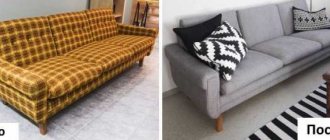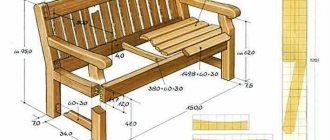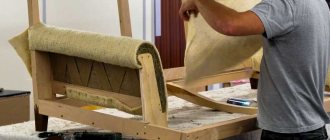0
13620
During use, upholstered furniture wears out and loses its original appearance. Dents in the seat, failure of the spring unit and damaged upholstery are the most common problems. You can solve them without serious expenses by repairing the sofa yourself, without resorting to the help of professionals. The work does not require special skills, but it must be done carefully and consistently.
Design and possible breakdowns
All upholstered furniture, regardless of design, includes basic elements. This:
- frame consisting of solid wood, metal or chipboard;
- soft part (foam rubber filler, spring block);
- upholstery, which uses furniture fabric, natural or artificial leather.
The sofa can be a sleeper or intended exclusively for sitting. The folding one, in addition to the listed elements, has a special transformation mechanism with which you can organize a place to rest at night. The failure of its elements is the main reason why the sofa does not function well. For restoration, you will have to determine the type of mechanism in order to repair it or install a new one. The most popular are:
- "Book". The most common. To recline the sofa, you need to raise the seat until you hear a click and then lower it.
- "Eurobook". The seat moves forward and the backrest lowers into the resulting space.
- “Click-clack.” Models with this mechanism have a metal frame, and you can transform the sofa in 2 ways - completely or in a reclining position.
- "Accordion". The back of the sofa is double-sided. It rises, extends, both parts straighten. Most often, due to high load, the elements of the mechanism are deformed; they cannot be repaired; replacement is necessary.
- "Dolphin". Most often found in corner models. The lower part of the sofa moves forward, which is leveled to the height of the seat using pillows or filler.
If the mechanism is not broken, but it is difficult to transform or the sofa does not fold out, it is necessary to inspect the structure and find out what is interfering with normal operation. Perhaps some furniture elements are bent or rusted. In this case, you can try to solve the problem without completely changing the mechanism. Other common breakdowns and methods for eliminating them are presented in the table.
| Problem | Cause | Solution |
| The seat is pressed through | Filler deformation | Replacing foam rubber in a sofa with your own hands or to order. They use a special furniture one, the thickness of which is from 40 mm or more. |
| Creak when pressing on the seat, uneven surface (dimples and bulges) | Spring unit malfunction | Inspection of the spring block, assessment of its condition. Repair or complete replacement |
| The sofa fell in the middle | The problem is in the frame | The frame is a frame made of wood or metal, covered on top with sheet material (furniture board, plywood or chipboard). It is the upper part that experiences a lot of stress, so it can crack over time. It is necessary to dismantle the damaged element and install a new one. If a wooden frame is cracked, disassemble it completely, make a part with similar parameters and replace it. It is impossible to repair a metal frame at home - you will need a welding machine |
| Torn, frayed or stained upholstery | Wear, mechanical damage | Furniture reupholstery |
Book
Eurobook
Click-clack
Accordion
Dolphin
Required Tools
Before you begin home renovations, the furniture needs to be disassembled. The necessary tools, consumables and new materials should be prepared to replace those that have become unusable. To repair a sofa yourself you will need:
- screwdriver;
- flat screwdriver;
- open-end wrenches (diameter 10, 12, 14 mm);
- pliers;
- corner key.
To troubleshoot problems you will also need:
- self-tapping screws;
- wood glue;
- furniture stapler and staples;
- construction knife;
- roulette;
- pencil.
To replace the upholstery, you will need furniture fabric or leather, to restore a dented sofa - a new spring block, filler (foam rubber or polyurethane, as well as padding polyester or batting). To repair the frame you will need bars and sheet material (plywood, chipboard). When repairing a corner sofa equipped with a dolphin sliding mechanism, new casters may be required. In cases where the metal frame is bent or cracked, you will not be able to straighten it yourself; you will need to replace the elements.
Tools
Repair materials
How to disassemble a sofa yourself
Repair work begins with disassembly. As you work, it is recommended to photograph each step so that during assembly you can see if everything is being done correctly. Procedure:
- Removing the armrests. They are fixed to the frame using bolts on the sides of the wooden frame. To open access to them, pull out or lift the seat (depending on the design of the furniture), then unscrew the fasteners with keys of the appropriate diameter.
- Removing the transformation mechanism. It is attached to the sides of the frame, backrest and seat. Using a screwdriver or Phillips screwdriver, unscrew the fasteners.
- Removing the backrest and seat. Both elements are connected to each other by a transformation mechanism. After removing the latter, they are easy to detach from each other and from the frame. In some models, the backrest may be screwed to the frame, then you need to remove the bolts holding it.
- Removing the upholstery. The back and seat are turned upside down, and using a flat-head screwdriver, the staples holding the fabric to the frame are carefully pulled out. Each piece of material is signed or marked so as not to get confused when re-stretching.
- Removing the filler and spring block. Between the upholstery and the foam rubber there is usually a layer of batting or padding polyester. Carefully remove it, unfastening the staples, then inspect the filler. If there are noticeable indentations, dirt or signs of destruction on it, remove it. Assess the degree of damage to the block. If there are burst springs, broken connections, or bent areas on the frame, you will have to replace it with a new one. The old one is removed by removing the nails or staples from the frame.
Removing the upholstery and further actions are performed only if the upholstered part of the sofa is repaired or the upholstery is changed. If there are problems with the frame or transformation mechanism, a complete disassembly is not required. In order to most accurately understand the possible scope of work, you should first familiarize yourself with thematic videos, for example, on the topic “Repairing upholstered furniture.”
Restoration process: step-by-step instructions
We check the frame and base of the sofa, replace it if it breaks
Before you restore the sofa with your own hands, you need to check the condition of the main frame. If there are cracked or sagging bars, it is better to replace them. Solid wood rarely requires repairs, but chipboard often breaks. It is not worth repairing; here you need to completely replace the broken part.
We drag the lower base of the sofa, using the old upholstery as a template
The repair of the back, seat and armrests is slightly different, but in general, the restoration scheme for various parts is approximately the same.
We replace the upholstery on the inside of the armrests, replace the filling and sew a new cover
First of all, you need to carry out dismantling work:
remove the side armrests (usually the bolts on them are made from the inside; here you may need a hexagonal spanner or pliers); remove the seats and backrests from the fasteners to the lower frame; remove the old upholstery, remove the staples too; Carefully dismantle the old filler and check for suitability for reuse; remove the springs, check their condition, if necessary, clean, lubricate, replace in whole or in part; Check the condition of the chipboard and replace the sheets if necessary.
We replace the outer part of the armrests and connect both parts together
It is better to put all the small parts from disassembly in one container so as not to lose them.
We fix the upholstery at the base, use a hammer and stapler if necessary
At the second stage, we replace the old elements. To fasten parts together, it is best to use both glue and a stapler. But if necessary, you can make do with handy means. For example, instead of a stapler, use small nails:
lay thick fabric on both sides of the spring block, bend the edges inward on each side and stitch with nylon thread; lay the spring frame on a wooden base, secure the springs through the fabric with a stapler. If you don’t have a tool, you can make arched staples from steel wire, or from thin nails, driving the “head” to the side; lay new, or suitable old, filler; tighten the entire structure with fastening fabric, like upholstery, and secure it; put on a new cover, secure with glue and a stapler.
Now it’s the turn of the back of our sofa - we do the work according to the same principle
How to repair it yourself, taking into account the type of damage
The sequence of repair actions depends on the type of breakdown. Often it is necessary to perform several operations at once. For example, along with changing the spring block, you can replace the foam rubber in the sofa.
Soft part
If the sofa sags and when you press on the seat, dents remain on it, then change the filling. After disassembling the furniture, removing the upholstery and internal contents, they begin cutting out parts from the new material. In a sofa, replacing foam rubber is done as follows:
- Spread a piece of new foam rubber on a flat surface and place the old one on top. Using a pen, trace the contours and cut out with a construction knife.
- Place the workpiece against the frame, check for any protruding parts, and cut off the excess if necessary.
- The lower part of the part is coated with wood glue.
- Place the workpiece on the frame and press firmly evenly.
After the glue has dried, a layer of batting or synthetic padding is laid on top of the filler, attaching the edges of the material to the underside of the frame with a stapler. The sofa is then covered with new upholstery. To increase the service life of furniture fabric, a non-woven lining can be additionally used.
Place the old one on the new piece of foam
We trace the contours with a pen
Cut along the contour with a construction knife
We attach the workpiece to the frame
Coat with wood glue
Place the workpiece on the frame and press firmly
Spring block
Replacing the spring block is not always necessary - if the main part is intact, then you can try to repair the problem areas. To do this you will need pliers, wire cutters and small diameter hardened wire. They start by inspecting the block. Bent springs can be returned to their original position using pliers without dismantling or disassembling the structure. If elements are damaged, they are replaced with new ones. To do this, carefully cut off the problematic spring with pliers, and install a new one in its place, tying it to the block with wire.
If there are a lot of broken springs in the sofa, you will have to completely dismantle the unit and install a new one.
Scheme of the spring block “snake”
Use pliers to straighten the bent spring
Damaged spring
We connect the springs to the block with wire
In budget models, instead of a spring block, a “snake” can be used - a structure made of individual thick springs attached to the sides of the frame at an equal distance from each other. The repair in this case is simple. Usually the loss of elasticity of the seat is caused by the detachment of one or more elements from the frame, so it is enough to fasten the spring back. If these products are cracked and there is no way to find new ones, textile belts are used. Procedure for repairing a spring block in a sofa:
- The tape is wound on a wooden block.
- The free end is applied to the place where the removed spring was located. Bend the tip and securely attach it to the frame using a furniture stapler.
- Apply the tape to the opposite end of the frame. To ensure high-quality tension, the bar is pulled back and the textile sling is nailed with staples, and the secured piece is cut off from the main skein.
In this way, you can not only solve the problem of missing springs, but also additionally cover the entire frame in order to extend the life of the “snake” and give the seat greater elasticity.
Using textile tape we strengthen the “snake” spring block
Frame
To repair the frame, the armrests, upper and lower parts of the structure are dismantled. Inspect parts and identify damage. If there are cracks in the frame, the structure is completely disassembled, measurements are taken of the broken element and a new part is made. For its manufacture, only dried wood is used - raw wood is deformed in the process, which will lead to new problems. If you don’t have the skills to work with the material, order a part according to your dimensions in a carpentry shop, then reassemble the frame. If necessary, strengthen the frame by installing additional transverse joists, screwing in furniture bolts or self-tapping screws at the joints of parts, and coating areas with a tongue-and-groove joint with wood glue.
Crack in the sofa frame
We cut out a new wooden block and fasten it with self-tapping screws
Transformation mechanism
Repair of a folding sofa most often involves replacing the transformation mechanism or its individual parts. Rust on this element may prevent you from laying out the sofa normally. To remove it, use special anti-corrosion sprays, for example, WD-40. The liquid is sprayed onto problem areas, and after the time indicated on the package has passed, wiped with a dry cloth. After this treatment, all parts are lubricated. Repairing the mechanisms of sofas with damaged (bent, cracked) elements is useless; a complete replacement is necessary. You need to purchase a structure of the same type and install it in place of the old one.
Sofa transformation mechanism
Lubricate individual parts of the mechanism with anti-corrosion agents
Case and cover
After disassembling the sofa, carefully remove the upholstery from all parts. Then:
- Lay the furniture fabric face down on the floor and straighten out all the folds.
- Lay old covers on top of it. Trace the contours with tailor's chalk, making allowances of 5-7 cm on each side.
- Cut out patterns with scissors.
- The cut fabric is spread on a flat surface with the wrong side on top. The part to be covered is placed on it, face down.
- The edges of the upholstery are brought to the back side and secured to the frame using a furniture stapler. The fabric should be stretched enough so that folds or wrinkles do not form on the surface of the product.
- First, the material is secured with 2 staples on each side, then, straightening it evenly, they are driven in along the entire perimeter of the frame.
Repairing sofas on your own is not a technologically complicated process, but it requires care and precision. With the right approach, you can return furniture to its functionality and original appearance at minimal cost. The restoration time will depend on the skills of the master and the amount of work.
We spread new furniture fabric on the floor, put old covers on it and make patterns
Using a stapler, we attach the fabric to the frame of the sofa along the entire perimeter, stretch it and straighten it.
Procedure for replacing upholstery fabric
Before carrying out the main work, the sofa must be disassembled. To avoid any difficulties with assembly in the future, it is important to remember the order of the parts. To do this, they are numbered or captured on camera. After disassembly, the mechanisms are inspected. Severe wear indicates the need to replace them.
Related article: How to disassemble an interior door handle without the help of a technician
Sofa upholstery options.
- First, the side parts are removed, the seat is raised and the bolts are unscrewed. Then the main device responsible for transforming the model is removed. The seat, backrest and frame should be unscrewed. The other elements of the sofa are also removed, leaving only the skeleton.
- Old upholstery must be removed very carefully to avoid damage. This canvas will be used as a pattern for the new coating. To remove the pillows, they are disconnected from the folding device. The old screws are unscrewed from each side.
- You can use a flat head screwdriver to remove the old upholstery fabric. The bracket is hooked onto it, the part gradually swings and is finally removed with pliers. Next, the sheathing is removed and the quality of the lining material is checked. If it is in good condition, it can remain in the same place, after which a new skin is stretched on top.
- Next, the cover is sewn. To do this you need to have skills in operating a sewing machine. The finished coating is secured with staples. When identifying the fabric on the surface, it is important to ensure its evenness; there should be no folds or wrinkles on it. Manually replacing the upholstery involves tying the front side; at the fixing points, the fabric is folded 2 times. Then you can move to the other side and subsequently to the corners.
In the same way, you can repair other elements of the device. Before starting work, you can put an additional pad under the fabric, which helps to increase the life of the sofa. The attachment points can be treated with a special glue, which will give the fabric the necessary hardness, and the fastener will be made reliably.











